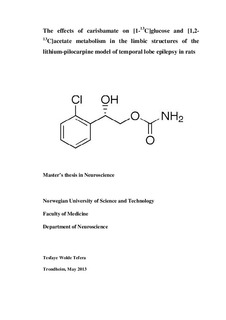| dc.description.abstract | TLE is a type of focal epilepsy which is often resistant to medication. There is a need for the development of new drugs to treat patients and, even more important, to prevent epileptogenesis. Carisbamate (CRS) showed strong neuroprotective and antiepiloptogenic properties in animal models. However, its mechanism of action is not yet clear. The aim of this project was to study neuronal and astrocytic metabolism in the limbic structures of rats using the lithium-pilocarpine model of TLE and to investigate the effects of CRS treatment on lithium-pilocarpine epileptic rats.
Status epilepticus (SE) was induced in rats by i.p. injection of lithium chloride followed by pilocarpine (25 mg/kg) 20 hrs later. CRS (90 mg/kg) was injected at 1 and 8 hr following SE and injections were repeated twice daily for 6 additional days. Another group received low doses of diazepam at 1 and 8 hrs after onset of SE and vehicle for 6 additional days. Lithium chloride and vehicle instead of pilocarpine and CRS were given to the control group. Two months after SE, animals were injected with [1- 13C]glucose and [1,2-13C]acetate i.p. Twenty minutes later the rats were subjected to microwave fixation. The brains were removed and the limbic structures (amygdala, piriform/entorhinal cortex) were dissected. The extracts from the limbic structures were analyzed using HPLC, 1H and 13C NMR spectroscopy.
Amounts of glutamate, aspartate, NAA, glutathione and taurine were reduced in the epileptic rats that didn’t receive CRS. Decreased labeling of glutamate and glutamine from [1- 13C]glucose was found. The transfer of glutamate from neurons to astrocytes was also impaired. These results show neuronal loss and/or disturbed mitochondrial neuronal metabolism. However, CRS treatment increased the amounts of glutamate, NAA, glutathione and taurine. CRS protected neurons and improved mitochondrial neuronal metabolism. The 13C labeling of [4,5-13C]glutamate/glutamine and [1,2- 13C]GABA from [1,2-13C]acetate was reduced in the untreated rats. These results show reduced astrocytic metabolism in the untreated epileptic rats. CRS treatment resulted in large amounts of glutamine, [4,5- 13C]glutamine and NAA in the ALE rats compared to the TLE group. In conclusion, lithium-pilocarpine caused reduced neuronal and astrocytic metabolism in the limbic structures of rats and CRS prevented a deterioration of neuronal metabolism while its effect on astrocytic metabolism was minimal. | nb_NO |
